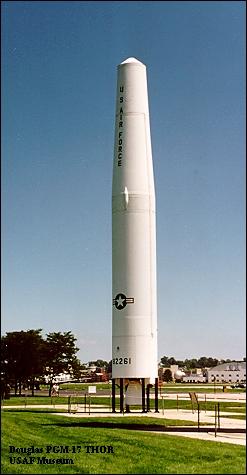

 |
 |
|
Thor Rocket 
Thor Rocket
The Thor rocket was a single-stage intermediate range ballistic missile (IRBM) originally designated as the SM-75. Propelled by liquid oxygen and kerosene, the basic rocket was 65 feet (19.8 meters) in length, had a body diameter of 8 feet (2.4 meters), and weighed 110,000 pounds (49,900 kilograms) at firing. The development contract for the Thor was signed with Douglas Aircraft in December 1955. Final design was completed in July 1956, and the first production model of the Thor was delivered to the U.S. Air Force at Cape Canaveral, Florida, for testing in October 1956, just 11 months later. This represented the shortest time span from conception to delivery for any U.S. missile program. The first four Thor test launches, beginning on January 25, 1957, were failures. However, these early failures received intensive study and a number of successful test flights followed. The missile entered active military service in September 1958, thus becoming the free world's first operational IRBM. The Thor was declared operational by 1959 and was assigned to the Strategic Air Command and also deployed to England where the Royal Air Force maintained them in a state of combat-readiness. With the development of more advanced missiles, the Thor was retired from its military role in 1963. However, some Thor missiles were modified and used extensively for the space program, where they formed the basis for the long-lasting Delta family of launch vehicles. The Thor was used either as a single-stage booster or in combination with various types of upper stages for such projects as Tiros, Telstar, Pioneer, and Discoverer. For space launches, three
additional small auxiliary motors were strapped to a Thor rocket that was used
as a first stage, resulting in the Thrust-Augmented Thor (Tat) that was nearly
twice as powerful as the original Thor. Adding an Agena rocket as a second
stage resulted in the two-stage Thor-Agena rocket that the U.S. Air Force used
to launch its Discoverer space satellites. Long Tank Thor, an advanced version of the Thor space launch vehicle, first appeared in the summer of 1966. It could place 20 percent heavier military payloads into space than Tat, had an overall length of 70.5 feet (21.5 meters), and a body diameter of 8 feet (2.4 meters). In 1960, the Thor-Delta, an improved Thor-based rocket, was introduced. Its name was officially shortened to Delta to distinguish it from military relatives that continued to carry the Thor name. From this time on, all Thor-based rockets launched from Cape Canaveral carried the Delta name only. However, military vehicles carrying the Thor name continued to be launched from Vandenberg Air Force Base, California, until 1972, when both military and civilian satellites were launched on vehicles bearing the Delta name. |